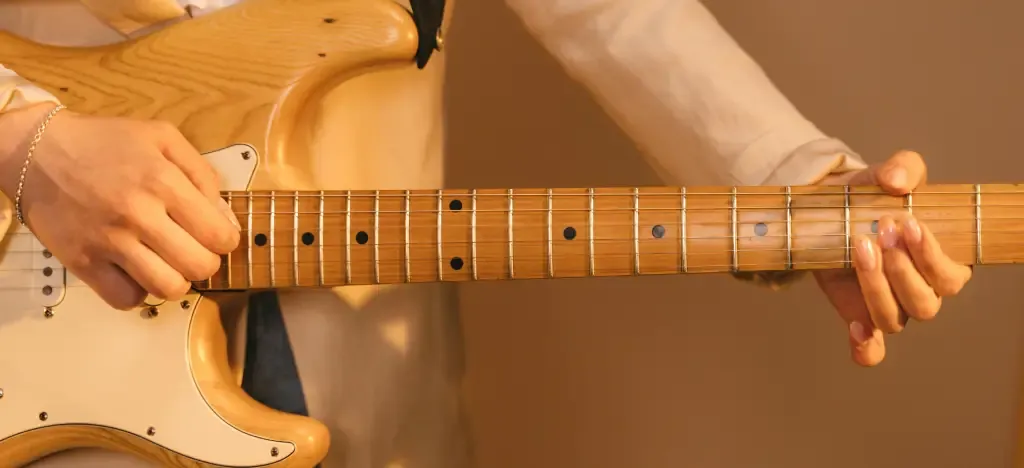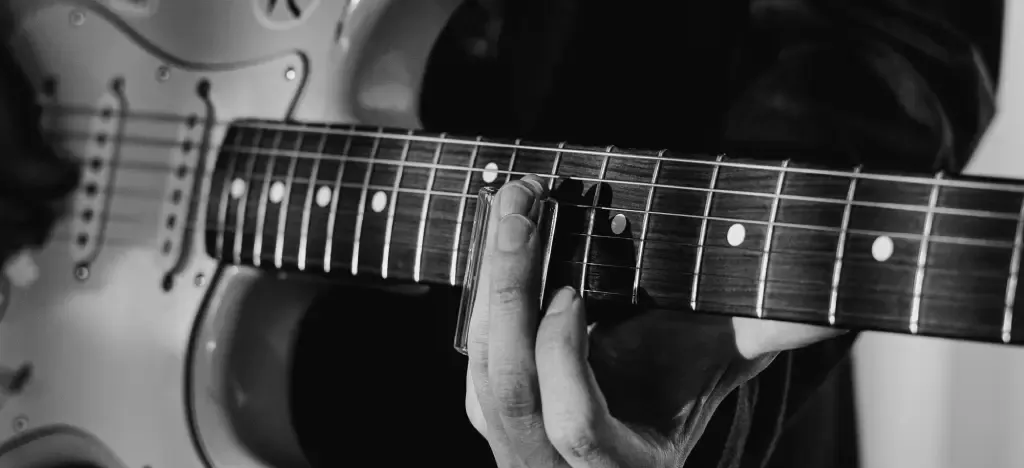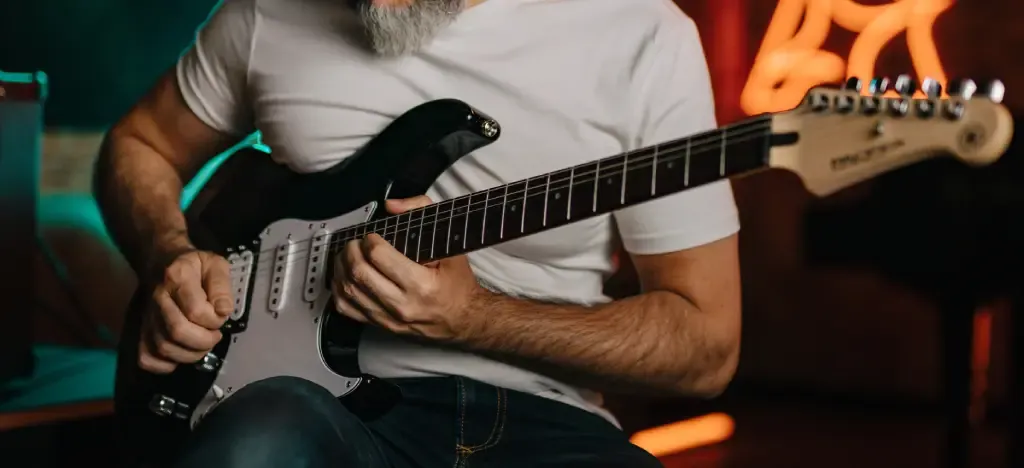The fastest way to sound better on guitar isn’t just learning more songs — it’s getting your technique right. Things like alternate picking, hammer-ons, bends, and vibrato are what really shape your sound. Get those down, and everything you play feels easier and more natural.
The good news is that most key guitar techniques are simple, once you understand them properly. Here’s what you need to know, including some easy exercises to start improving and a free video tutorial by viral soloist Kfir Ochaion.
- What are the essential guitar techniques?
- 1. Alternate picking: Build your speed the right way
- 2. Hammer-ons and pull-offs: Play smoother without working harder
- 3. Bending: Hit the note, not just the string
- 4. Vibrato: Bring your notes to life
- See how soloist Kfir Ochaion does vibrato
- 5. Palm muting: Keep it tight
- 6. Guitar sliding: Make your playing flow
- 7. Guitar tapping: Add some flash
- Put in a bit of time and it’ll pay off
- FAQS: Essential guitar techniques
What are the essential guitar techniques?
There are a handful of techniques that show up in just about everything. Alternate picking, hammer-ons and pull-offs, string bending, vibrato, sliding, palm muting, and tapping. You don’t need to be a shredder to use them, but ignoring them can make everything sound flat.
Let’s start with the one that’s probably already sneaking into your playing whether you realise it or not: alternate picking.
1. Alternate picking: Build your speed the right way
Alternate picking is picking down and up, down and up, one after the other — not just hammering downstrokes all the time. It keeps your hand moving smoothly and saves you a lot of effort when things get faster. If you’re not using alternate picking, you’ll eventually hit a wall where you just can’t keep up.
How to start:
Pick a string. Play four notes: down, up, down, up.
Use small, relaxed movements — it’s not about stabbing at the string.
Slow it down until you could almost do it in your sleep.
Once your hand moves cleanly, speed will happen naturally.
Alternate picking makes faster and smoother playing possible without extra effort.
💡 ARTMASTER TIP: Want to know how to dial in the perfect tone? Find out how to sound like your guitar heroes — even if you don’t have their gear
2. Hammer-ons and pull-offs: Play smoother without working harder
 Hammer-ons and pull-offs are about making your fingers do some of the work instead of relying on the pick every time.
Hammer-ons and pull-offs are about making your fingers do some of the work instead of relying on the pick every time.
A hammer-on is when you sound a note by pressing your finger down hard enough on the string. A pull-off is when you pluck the string a little with your fretting finger as you lift it off. Together, they let you move quickly and smoothly between notes without picking each one.
How to start:
Pick the 5th fret on a string.
Hammer your finger onto the 7th fret without picking again.
Then pull your finger off back to the 5th — flick the string a little as you lift.
At first it’ll be messy and quiet. That’s normal. It gets stronger fast if you stick at it.
Hammer-ons and pull-offs let you move between notes smoothly without wearing out your picking hand.
💡 ARTMASTER TIP: If you're not totally confident reading guitar tabs yet, it's worth getting that sorted now — it'll make learning and practising new techniques like this way easier. Check out our simple guide to reading guitar tabs here.
3. Bending: Hit the note, not just the string
Bending is where most players give themselves away. Anyone can grab a string and yank it upwards, but hitting the right note — cleanly, confidently — is what separates a bend that sounds emotional from a bend that sounds like a dying cat.
Good bending isn’t just about strength. It’s about control. You’re aiming to stretch the string just enough to hit the next note.
How to start:
Play a note, bend it until it matches the pitch of the fret above.
Listen — properly listen. If it’s too flat or sharp, adjust. Your ear will get better faster than you think.
Good bending brings real feeling into your solos and helps you hit the notes that matter.
💡 ARTMASTER TIP: If your guitar’s even slightly out of tune, no amount of practice will make your bends sound right. If you’re not confident tuning yet, here’s a simple guide to get you sorted.
4. Vibrato: Bring your notes to life
Vibrato is what you do after a note is played — shaking it gently up and down so the pitch wobbles slightly. It’s not random — it’s controlled. A good vibrato makes a note sound alive instead of flat and dead, and adds feeling to every sustained note you play.
How to start:
Hold a fretted note firmly.
Rock your hand slightly, bending and releasing the string in a steady rhythm.
Small, even movements sound better than big, jerky ones.
Practise slowly so you can control it without thinking.
Vibrato gives a single note the life and emotion that can make it unforgettable.
See how soloist Kfir Ochaion does vibrato
Kfir Ochaion knows how to make a single note sound like a moment. In this free vibrato lesson from his Guitar Solo course, you’ll see exactly how he does it — and how you can start doing it too.
5. Palm muting: Keep it tight
Palm muting means resting the side of your picking hand lightly on the strings, just near the bridge. It shortens the vibration of the strings, making the notes sound tighter and more percussive. It’s what gives riffs that heavy, chunky sound — or helps rhythm parts stay controlled instead of messy.
How to start:
Play a power chord normally.
Now rest your picking hand lightly on the strings right next to the bridge.
You want to hear a muted, chuggy sound — not a complete dead thud.
It takes a bit of shifting your hand to find the right spot.
Palm muting tightens up your rhythm playing and makes your riffs sound punchier and more controlled.
6. Guitar sliding: Make your playing flow
 Sliding is when you move your fretting finger smoothly from one fret to another without lifting it off the string. Instead of stopping and re-picking, you glide between notes. It makes phrases sound much more connected and natural.
Sliding is when you move your fretting finger smoothly from one fret to another without lifting it off the string. Instead of stopping and re-picking, you glide between notes. It makes phrases sound much more connected and natural.
How to start:
Pick a note on the 5th fret.
Without lifting your finger, slide it up to the 7th fret in one movement.
Don’t let the sound drop off — keep pressure down as you slide.
Practise sliding both up and down until it feels easy.
Sliding connects notes in a way that makes phrases sound natural and effortless.
💡 ARTMASTER TIP: If you want your slides — and everything else — to stay in time and feel tight, it’s worth getting comfortable with a metronome early on. Here’s a simple guide on how to use a metronome properly.
7. Guitar tapping: Add some flash
Tapping is like an extension of hammer-ons and pull-offs — but now you’re using a finger from your picking hand too. You tap the string onto the fretboard to sound a note, then pull off and hammer on like normal. It lets you play notes quickly over a bigger range without huge finger stretches.
How to start:
Pick the 5th fret, hammer-on to the 8th, then tap the 12th fret with your picking hand’s middle finger.
Pull-off back to the 8th, then pull-off again to the 5th.
It feels awkward at first, but once you get the basic motion, it unlocks loads of new sounds.
Tapping opens up fast, wide patterns you can’t easily reach with one hand alone.
Put in a bit of time and it’ll pay off
All of this comes down to one thing: If you understand what you’re doing, and you put in a bit of focused practice every day, you’ll get better — faster than you probably expect.
You don’t need hours and hours.
Ten minutes on one technique at a time is enough.
It’s about doing it right — not just doing it fast.
If you fix these basics now, everything you want to play later — solos, riffs, songs you love — will feel a whole lot easier.
If you want to push your skills further, Kfir Ochaion’s courses on Guitar soloing break down everything you need to know — how to build strong vibrato, perfect your bending, shape phrasing that sounds natural, and start creating solos that actually say something.
Try it for free with your 7-day free trial!
FAQS: Essential guitar techniques
What are the essential guitar techniques every player should learn?
Techniques like alternate picking, hammer-ons and pull-offs, string bending, vibrato, sliding, palm muting, and tapping form the backbone of expressive guitar playing across most genres.
Which technique should I learn first?
Start with alternate picking. It’s the most useful for building speed, control, and rhythm — and it sneaks into almost everything, even simple riffs.
How can I practise hammer-ons and pull-offs effectively?
Use basic scale patterns or simple licks. Start slow, focus on clarity and timing, and aim to hear every note evenly without picking each one.
Why does my string bending sound off?
Most likely you’re not bending far enough (or you’re bending too far). Use a tuner to check you’re hitting the target pitch — and always listen closely to match the intended note.
Is tapping only for advanced players?
Not at all. It looks flashy, but once you’ve got good timing and finger strength, basic tapping patterns are totally doable — and fun.
Do I need all of these to sound good?
No — but the more of them you use, the more natural and expressive your playing will become. Even just adding vibrato and bends can make simple solos sound miles better.
About the author
Matt Ford is a musician, teacher, writer, and lifelong student of sound.
With years of experience in both performing and teaching, he shares practical advice through ArtMaster to help musicians at every level build skill and confidence in their playing.

